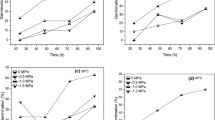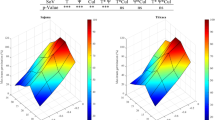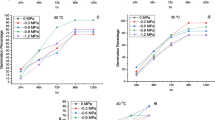Abstract
This study evaluated the ability of a hydrothermal time model (HTT) to describe the kinetics of watermelon (Citrullus vulgaris cv. ‘Crimson sweet’) seed germination under different temperatures (T) and water potentials (ψ) and also to determine the cardinal temperatures of watermelon. Results indicated that ψ influenced germination rate and germination percentage. For this seed lot, cardinal temperatures were 10 °C for T b, 28.34 °C for T o and 40.8 °C for T c in the control (0 MPa) treatment. There was a decrease in hydrotime constant (θ H) when T was increased to T o and then remained constant at supra-optimal temperatures (30 MPah−1). Also, at temperatures above T o, ψ b(50) values increased linearly with T. The k T value (the slope of the relationship between ψ b(50) and T exceeds T o) of this seed lot was calculated as 0.076 MPa°Ch−1. Results this study show that when the HTT model is applied, it can accurately describe ψ b(g) and the course of germination around Ts (R 2 = 0.82). Moreover, the ψ b(50) was estimated to be −0.96 MPa based on this model. Consequently, the germination response of watermelon for all Ts and ψs can be adequately described by the HTT model and enabling it to be used as a predictive tool in watermelon seed germination simulation models.




Similar content being viewed by others
Abbreviations
- FGP:
-
Final germination percentage
- GP:
-
Germination percentage
- GR:
-
Germination rate
- HTT:
-
Hydrothermal time model
- k T :
-
The slope of the relationship between ψb(50) and T exceeds T o
- MPa:
-
Megapascal
- T :
-
Temperature
- T b :
-
Minimum temperature
- T c :
-
Maximum temperature
- t g :
-
The time required for a fraction or percentage of germination
- T o :
-
Optimum temperature
- TT:
-
Thermal time model
- θ H :
-
Hydrotime model
- σψ b :
-
Standard deviation of ψ b within the seed population
- ψ :
-
Water potential
- ψ b(50) :
-
The base ψ of the 50th percentile
- ψ b :
-
Base water potential
References
Alvarado V, Bradford KJ (2002) A hydrothermal time model explains the cardinal temperatures for seed germination. Plant, Cell Environ 25:1061–1069. doi:10.1046/j.1365-3040.2002.00894.x
Atashi S, Bakhshandeh E, Mehdipour M, Jamali M, Teixeira da Silva JA (2014a) Application of a hydrothermal time seed germination model using the Weibull distribution to describe base water potential in zucchini (Cucurbita pepo L.). J Plant Growth Regul. doi:10.1007/s00344-014-9452-y
Atashi S, Bakhshandeh E, Zeinali Z, Yassari E, Teixeira da Silva JA (2014b) Modeling seed germination in Melisa officinalis L. in response to temperature and water potential. Acta Physiol Plant 36:605–611. doi:10.1007/s11738-013-1436-1
Bakhshandeh E, Atashi S, Hafea-Nia M, Pirdashti HA (2013) Quantification of the response of germination rate to temperature in sesame (Sesamum indicum). Seed Sci Technol 41:469–473
Baskin CC, Baskin JM (2014) Seeds: ecology, biogeography, and evolution of dormancy and germination. Academic Press, San Diego, p 1600
Bewley JD, Bradford KJ, Hilhorst HWM, Nonogaki H (2013) Seeds: physiology of development, germination and dormancy, 3rd edn. Springer, New York, p 407
Bradford KJ (1990) A water relations analysis of seed germination rates. Plant Physiol 94:840–849. doi:10.1104/pp.94.2.840
Bradford KJ (2002) Applications of hydrothermal time to quantifying and modeling seed germination and dormancy. Weed Sci 50:248–260. doi:10.1614/0043-1745(2002)050[0248:AOHTTQ]2.0.CO;2
Bradford KJ, Still DV (2004) Applications of hydrotime analysis in seed testing. Seed Technol 26:75–85
Dahal P, Bradford KJ (1990) Effects of priming and endosperm integrity on seed germination rates of tomato genotypes II. Germination at reduced water potential. J Exp Bot 41:1441–1453. doi:10.1093/jxb/41.11.1441
Dahal P, Bradford KJ (1994) Hydrothermal time analysis of tomato seed germination at suboptimal temperature and reduced water potential. Seed Sci Res 4:71–80. doi:10.1017/S0960258507383141
Demir I, Mavi K (2004) The effect of priming on seedling emergence of differentially matured watermelon (Citrullus lanatus (Thunb.) Matsum and Nakai) seeds. Sci Hortic 102:467–473. doi:10.1016/j.scienta.2004.04.012
Garcia AL, Recasens J, Forcella F, Torra J, Royo-Esnal A (2013) Hydrothermal emergence model for ripgut brome (Bromus diandrus). Weed Sci 61:146–153. doi:10.1614/WS-D-12-00023.1
Grundy A, Phelps K, Reader R, Burston S (2000) Modelling the germination of Stellaria media using the concept of hydrothermal time. New Phytol 148:433–444. doi:10.1046/j.1469-8137.2000.00778.x
Gummerson R (1986) The effect of constant temperatures and osmotic potential on the germination of sugar beet. J Exp Bot 41:1431–1439. doi:10.1093/jxb/41.11.1431
Kebreab E, Murdoch AJ (1999) Modelling the effects of water stress and temperature on germination rate of Orobanche aegyptiaca seeds. J Exp Bot 50:655–664. doi:10.1093/jxb/50.334.655
Kebreab E, Murdoch AJ (2000) The effect of water stress on the temperature range for germination of Orobanche aegyptiaca seeds. Seed Sci Res 10:127–133. doi:10.1017/S0960258500000131
Kurtar ES (2010) Modelling the effect of temperature on seed germination in some cucurbits. African J Biotech 9:1343–1353
Maynard DN, Hochmuth GJ (2007) Knott’s handbook for vegetable growers, 5th edn. Wiley, USA, p 630
Rowse HR, Finch-Savage WE (2003) Hydrothermal threshold models can describe the germination response of carrot (Daucus carota) and onion (Allium cepa) seed populations across both sub- and supra-optimal temperatures. New Phytol 158:101–108. doi:10.1046/j.1469-8137.2003.00707.x
SAS Institute (2004) SAS/STAT user’s guide. SAS Institute Inc., Cary
Schutte BJ, Regnier EE, Harrison SK, Schmoll JT, Spokas K, Forcella F (2008) A hydrothermal seedling emergence model for giant ragweed (Ambrosia trifida). Weed Sci 56:555–560. doi:10.1614/WS-07-161.1
Singh S, Singh P, Sanders DC, Wehner TC (2001) Germination of watermelon seeds at low temperature. Rep Cucurbit Genet Coop 24:59–64
Vleeshouwers L, Kropff M (2000) Modelling field emergence patterns in arable weeds. New Phytol 148:445–457. doi:10.1046/j.1469-8137.2000.00773.x
Wang R (2005) Modeling seed germination and seedling emeregence in winterfat (Krascheninnikovia lanata (Pursh) A.D.J. Meeuse & Smit): physiological mechanisms and ecoligical relevance. Ph.D. thesis, University of Saskatchewan, p 190
Watt MS, Xu V, Bloomberg M (2010) Development of a hydrothermal time seed germination model which uses the Weibull distribution to describe base water potential. Ecol Modelling 221:1267–1272. doi:10.1016/j.ecolmodel.2010.01.017
Watt MS, Bloomberg M, Finch-Savage WE (2011) Development of a hydrothermal time model that accurately characterises how thermoinhibition regulates seed germination. Plant, Cell Environ 34:870–876. doi:10.1111/j.1365-3040.2011.02292.x
Zhang H, Irving L, Tian Y, Zhou D (2012) Influence of salinity and temperature on seed germination rate and the hydrotime model parameters for the halophyte, Chloris virgata, and the glycophyte, Digitaria sanguinalis. South African J Bot 78:203–210. doi:10.1016/j.sajb.2011.08.008
Acknowledgments
The advice and commentary provided by Dr. Kent J. Bradford (Department of Vegetable Crops, University of California, Davis, USA) is gratefully acknowledged.
Author information
Authors and Affiliations
Corresponding author
Additional information
Communicated by A. Gniazdowska-Piekarska.
Rights and permissions
About this article
Cite this article
Bakhshandeh, E., Atashi, S., Hafeznia, M. et al. Hydrothermal time analysis of watermelon (Citrullus vulgaris cv. ‘Crimson sweet’) seed germination. Acta Physiol Plant 37, 1738 (2015). https://doi.org/10.1007/s11738-014-1738-y
Received:
Revised:
Accepted:
Published:
DOI: https://doi.org/10.1007/s11738-014-1738-y




